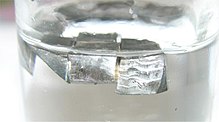 Global Information
Global InformationLithium information
 Lithium floating in oil | |||||||||||||||||||||
| Lithium | |||||||||||||||||||||
|---|---|---|---|---|---|---|---|---|---|---|---|---|---|---|---|---|---|---|---|---|---|
| Pronunciation | /ˈlɪθiəm/ | ||||||||||||||||||||
| Appearance | silvery-white | ||||||||||||||||||||
| Standard atomic weight Ar°(Li) | |||||||||||||||||||||
| |||||||||||||||||||||
| Lithium in the periodic table | |||||||||||||||||||||
| |||||||||||||||||||||
| Atomic number (Z) | 3 | ||||||||||||||||||||
| Group | group 1: hydrogen and alkali metals | ||||||||||||||||||||
| Period | period 2 | ||||||||||||||||||||
| Block | s-block | ||||||||||||||||||||
| Electron configuration | [He] 2s1 | ||||||||||||||||||||
| Electrons per shell | 2, 1 | ||||||||||||||||||||
| Physical properties | |||||||||||||||||||||
| Phase at STP | solid | ||||||||||||||||||||
| Melting point | 453.65 K (180.50 °C, 356.90 °F) | ||||||||||||||||||||
| Boiling point | 1603 K (1330 °C, 2426 °F) | ||||||||||||||||||||
| Density (at 20° C) | 0.5334 g/cm3[3] | ||||||||||||||||||||
| when liquid (at m.p.) | 0.512 g/cm3 | ||||||||||||||||||||
| Critical point | 3220 K, 67 MPa (extrapolated) | ||||||||||||||||||||
| Heat of fusion | 3.00 kJ/mol | ||||||||||||||||||||
| Heat of vaporization | 136 kJ/mol | ||||||||||||||||||||
| Molar heat capacity | 24.860 J/(mol·K) | ||||||||||||||||||||
Vapor pressure
| |||||||||||||||||||||
| Atomic properties | |||||||||||||||||||||
| Oxidation states | 0[4], +1 (a strongly basic oxide) | ||||||||||||||||||||
| Electronegativity | Pauling scale: 0.98 | ||||||||||||||||||||
| Ionization energies |
| ||||||||||||||||||||
| Atomic radius | empirical: 152 pm | ||||||||||||||||||||
| Covalent radius | 128±7 pm | ||||||||||||||||||||
| Van der Waals radius | 182 pm | ||||||||||||||||||||
| Other properties | |||||||||||||||||||||
| Natural occurrence | primordial | ||||||||||||||||||||
| Crystal structure | body-centered cubic (bcc) (cI2) | ||||||||||||||||||||
| Lattice constant |  | ||||||||||||||||||||
| Thermal expansion | 46.56×10−6/K (at 20 °C)[3] | ||||||||||||||||||||
| Thermal conductivity | 84.8 W/(m⋅K) | ||||||||||||||||||||
| Electrical resistivity | 92.8 nΩ⋅m (at 20 °C) | ||||||||||||||||||||
| Magnetic ordering | paramagnetic | ||||||||||||||||||||
| Molar magnetic susceptibility | +14.2×10−6 cm3/mol (298 K)[5] | ||||||||||||||||||||
| Young's modulus | 4.9 GPa | ||||||||||||||||||||
| Shear modulus | 4.2 GPa | ||||||||||||||||||||
| Bulk modulus | 11 GPa | ||||||||||||||||||||
| Speed of sound thin rod | 6000 m/s (at 20 °C) | ||||||||||||||||||||
| Mohs hardness | 0.6 | ||||||||||||||||||||
| Brinell hardness | 5 MPa | ||||||||||||||||||||
| CAS Number | 7439-93-2 | ||||||||||||||||||||
| History | |||||||||||||||||||||
| Discovery | Johan August Arfwedson (1817) | ||||||||||||||||||||
| First isolation | William Thomas Brande (1821) | ||||||||||||||||||||
| Isotopes of lithium | |||||||||||||||||||||
| |||||||||||||||||||||
Lithium (from Ancient Greek λίθος (líthos) 'stone') is a chemical element; it has symbol Li and atomic number 3. It is a soft, silvery-white alkali metal. Under standard conditions, it is the least dense metal and the least dense solid element. Like all alkali metals, lithium is highly reactive and flammable, and must be stored in vacuum, inert atmosphere, or inert liquid such as purified kerosene or mineral oil. It exhibits a metallic luster. It corrodes quickly in air to a dull silvery gray, then black tarnish. It does not occur freely in nature, but occurs mainly as pegmatitic minerals, which were once the main source of lithium. Due to its solubility as an ion, it is present in ocean water and is commonly obtained from brines. Lithium metal is isolated electrolytically from a mixture of lithium chloride and potassium chloride.
The nucleus of the lithium atom verges on instability, since the two stable lithium isotopes found in nature have among the lowest binding energies per nucleon of all stable nuclides. Because of its relative nuclear instability, lithium is less common in the solar system than 25 of the first 32 chemical elements even though its nuclei are very light: it is an exception to the trend that heavier nuclei are less common.[7] For related reasons, lithium has important uses in nuclear physics. The transmutation of lithium atoms to helium in 1932 was the first fully human-made nuclear reaction, and lithium deuteride serves as a fusion fuel in staged thermonuclear weapons.[8]
Lithium and its compounds have several industrial applications, including heat-resistant glass and ceramics, lithium grease lubricants, flux additives for iron, steel and aluminium production, lithium metal batteries, and lithium-ion batteries. These uses consume more than three-quarters of lithium production.[citation needed][when?]
Lithium is present in biological systems in trace amounts. It has no established metabolic function. Lithium-based drugs are useful as a mood stabilizer and antidepressant in the treatment of mental illness such as bipolar disorder.
- ^ "Standard Atomic Weights: Lithium". CIAAW. 2009.
- ^ Prohaska, Thomas; Irrgeher, Johanna; Benefield, Jacqueline; Böhlke, John K.; Chesson, Lesley A.; Coplen, Tyler B.; Ding, Tiping; Dunn, Philip J. H.; Gröning, Manfred; Holden, Norman E.; Meijer, Harro A. J. (4 May 2022). "Standard atomic weights of the elements 2021 (IUPAC Technical Report)". Pure and Applied Chemistry. doi:10.1515/pac-2019-0603. ISSN 1365-3075.
- ^ a b c Arblaster, John W. (2018). Selected Values of the Crystallographic Properties of Elements. Materials Park, Ohio: ASM International. ISBN 978-1-62708-155-9.
- ^ Li(0) atoms have been observed in various small lithium-chloride clusters; see Milovanović, Milan; Veličković, Suzana; Veljkovićb, Filip; Jerosimić, Stanka (30 October 2017). "Structure and stability of small lithium-chloride LinClm(0,1+) (n ≥ m, n = 1–6, m = 1–3) clusters". Physical Chemistry Chemical Physics. 19 (45): 30481–30497. doi:10.1039/C7CP04181K. PMID 29114648.
- ^ Weast, Robert (1984). CRC, Handbook of Chemistry and Physics. Boca Raton, Florida: Chemical Rubber Company Publishing. pp. E110. ISBN 0-8493-0464-4.
- ^ Kondev, F. G.; Wang, M.; Huang, W. J.; Naimi, S.; Audi, G. (2021). "The NUBASE2020 evaluation of nuclear properties" (PDF). Chinese Physics C. 45 (3): 030001. doi:10.1088/1674-1137/abddae.
- ^ Numerical data from: Lodders, Katharina (10 July 2003). "Solar System Abundances and Condensation Temperatures of the Elements" (PDF). The Astrophysical Journal. 591 (2). The American Astronomical Society: 1220–1247. Bibcode:2003ApJ...591.1220L. doi:10.1086/375492. S2CID 42498829. Archived from the original (PDF) on 7 November 2015. Retrieved 1 September 2015. Graphed at File:SolarSystemAbundances.jpg
- ^ Nuclear Weapon Design. Federation of American Scientists (21 October 1998). fas.org
